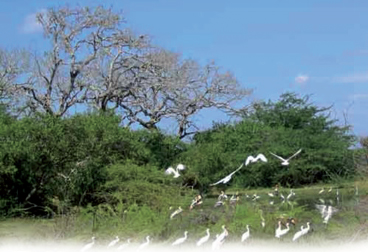
Bundala National Park
Once the subject of controversy due to the Weerawila Airport that
would have been built today, the Bundala National Park is a protected
wildlife national park which is a showcase for the best of Mother
Nature. Bundala is comfortably accessible to birds during their
migration, along the coastline between the town of Hambantota and
Kirindi Oya. In total, the area of the park encompasses 6216 hectares.
The Park is a Mecca for bird-watchers and wildlife enthusiasts in
addition to naturalists.
 Bundala National Park is ideal for quick satisfaction; a four hour
jeep ride is all what it takes to see everything from elephants, 8ft
crocodiles, giant squirrels to even flamingoes! Afternoon safaris in the
dry season (December - May) offer tourists and visitors the opportunity
to make a date with wildlife. Due to its significant role as a wintering
site for migratory birds, this was declared a RAMSAR wetland in 1990. Bundala National Park is ideal for quick satisfaction; a four hour
jeep ride is all what it takes to see everything from elephants, 8ft
crocodiles, giant squirrels to even flamingoes! Afternoon safaris in the
dry season (December - May) offer tourists and visitors the opportunity
to make a date with wildlife. Due to its significant role as a wintering
site for migratory birds, this was declared a RAMSAR wetland in 1990.
The most famous visitors to the Park are the stunning flocks of
gorgeous flamingoes. The Bundala area is the flamingoes’ last refuge in
the southern part of Sri Lanka and you can see them displaying their
finest of feathers for all to see. Grouped in variable numbers
throughout the year, their exact breeding habits is unknown though some
experts say that they migrate from the Rann of Kutch in northern India.
Up to 2000 flamingoes have been recorded and out of them, 350 flamingoes
have made Bundala their year-round home.
Bundala National Park is a blend of scrub jungle and sandy
semi-desert with sand dunes bordering the sea.
Being Sri Lanka’s foremost wildlife destinations, the park protects
an important area of coastal wetland famous for its abundant aquatic
(and other) birdlife.
The park is also home to significant populations of elephants, marsh
and estuarine crocodiles, turtles and other fauna, including leopards.
A total of 197 bird species have been recorded here, made up of 139
resident species and 58 seasonal visitors, the latter arriving during
the northern winter (Sept- March). Endemic birds include the
Brown-capped Babbler, Ceylon Woodshrike and Ceylon Junglefowl.During the
northern winter large numbers of migrants such as Golden and Kentish
Plover, Large and Lesser Sandplovers, Marsh and Curlew Sandpiper, Curlew
and Greenshank arrive.
Rarities include the Broad-billed Sandpiper and Red-necked Phalarope.
Bundala’s lagoons, beaches, sand dunes and scrubby jungle stretch
nearly 20km along a coastal strip starting just east of Hambantota
passes along Bundala’s northern boundary.
The Karagan, Maha and particularly Bundala lewayas (salt pans) are
also excellent for shore-bird enthusiasts.The park stretches along the
coast for around 20 km, enclosing five shallow and brackish lagoons, or
lewayas (they sometimes dry up completely during long periods of
drought) separated by thick low scrubby forest running down to coastal
dunes. The vegetation types within the park include scrub with scattered
taller trees,and narrow strips of marshland.
- ND
|

